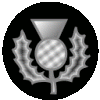9th (Scottish) Division: Difference between revisions
m Disambiguate Fourth Battle of Ypres to Battle of the Lys (1918) using popups |
No edit summary |
||
| Line 27: | Line 27: | ||
The '''9th (Scottish) Division''', was one of the [[Kitchener's Army]] [[division (military)|division]]s raised from volunteers by [[Horatio Kitchener, 1st Earl Kitchener of Khartoum|Lord Kitchener]] to serve on the [[Western Front]] during the [[World War I|First World War]]. |
The '''9th (Scottish) Division''', was one of the [[Kitchener's Army]] [[division (military)|division]]s raised from volunteers by [[Horatio Kitchener, 1st Earl Kitchener of Khartoum|Lord Kitchener]] to serve on the [[Western Front]] during the [[World War I|First World War]]. |
||
After the [[South African Brigade]] joined in early 1916, the division was known [[colloquial]]ly as the ''[[Jock]]s and [[Springbok]]s''. |
After the [[1st Infantry Brigade (South Africa)|1st South African Infantry Brigade Group]] joined in early 1916, the division was known [[colloquial]]ly as the ''[[Jock]]s and [[Springbok]]s''. |
||
==Unit history== |
==Unit history== |
||
Revision as of 14:18, 29 April 2010
| 9th (Scottish) Division | |
|---|---|
 | |
| Active | World War I 21 August 1914 - 16 March 1919 |
| Country | United Kingdom |
| Branch | New Army |
| Type | Infantry |
| Engagements | Battle of Loos Battle of the Somme First Battle of Ypres Ludendorff Offensive Battle of Messines Battle of Bailleul Battle of Kemmel Ridge Battle of Scherpenberg Battle of the Lys Salient Fourth Battle of Ypres Battle of Courtrai (1918) Battle of Ooteghem |
The 9th (Scottish) Division, was one of the Kitchener's Army divisions raised from volunteers by Lord Kitchener to serve on the Western Front during the First World War.
After the 1st South African Infantry Brigade Group joined in early 1916, the division was known colloquially as the Jocks and Springboks.
Unit history
In the Battle of Loos, notable for being the first battle in which British forces used poison gas, the 9th (Scottish ) Division assaulted the Hohenzollern Redoubt, the 5th Camerons suffered horrific casualties, and Corporal James Dalgleish Pollock gained a Victoria Cross for his actions.
The 9th (Scottish) Division took part in major fighting during the Somme offensive. Notably it relieved the 30th Division at Montauban and later attacked German positions at Bernafay Wood, where it succeeded in capturing vital objectives and forcing a German withdrawal.
Formation
The division comprised the following brigades:
- 26th Brigade
- 8th Battalion, The Black Watch (Royal Highlanders)
- 7th Battalion, Seaforth Highlanders (Ross-shire Buffs, The Duke of Albany's)
- 8th Battalion, the Gordon Highlanders[1]
- 5th Battalion, The Queen's Own Cameron Highlanders
- 10th Battalion, Princess Louise's (Argyll & Sutherland Highlanders) [2]
- 11th Battalion, the Royal Scots (Lothian Regiment)
- 12th Battalion, the Royal Scots (Lothian Regiment)
- 6th Battalion, the Royal Scots Fusiliers [3]
- 10th Battalion, Princess Louise's (Argyll and Sutherland Highlanders) [2]
- 6th Battalion, King's Own Scottish Borderers [4]
- 9th Battalion, The Cameronians (Scottish Rifles) [5]
- 28th Brigade [6]
- 6th Battalion, The King's Own Scottish Borderers [4]
- 9th Battalion, The Cameronians (Scottish Rifles) [5]
- 10th Battalion, The Highland Light Infantry [7]
- 11th Battalion, The Highland Light Infantry [7]
- 1st (South African) Brigade [8]
- 1st Battalion, South African Infantry [9]
- 2nd Battalion, South African Infantry [9]
- 3rd Battalion, South African Infantry
- 4th Battalion, South African Infantry [9]
- Pioneers
- 9th Battalion, Seaforth Highlanders (Rosshire Buffs, The Duke of St. Albany's)
Commanders
- Major-General C. Mackenzie 27 August 1914
- Brigadier-General S. Scrase-Dickens (Acting) 11 October 1914
- Lieutenant-General. Sir Charles Fergusson 26 October 1914
- Brigadier-General S. Scrase-Dickens (Acting) 31 December 1914
- Major-General H. Landon 21 January 1915
- Major-General George Thesiger 9 September 1915 Killed in action
- Major-General E. Bulfin (Temporary) 27 September 1915
- Major-General William Furse 28 September 1915
- Major-General Henry Lukin 2 December 1916
- Brigadier-General H. Tudor (Acting) 4 March 1918
- Major-General C. Blacklock 13 March 1918
- Brigadier-General H. Tudor (Acting) 16 March 1918
- Major-General H. Tudor 28 March 1918
Battles
- Battle of Loos
- Battle of the Somme
- First Battle of Ypres
- Ludendorff Offensive
- Battle of Messines
- Battle of Bailleul
- Battle of Kemmel Ridge
- Battle of Scherpenberg
- Battle of the Lys Salient
- Fourth Battle of Ypres
- Battle of Courtrai (1918)
- Battle of Ooteghem
Notes
- ^ Transferred to 15th Division and amalgamated with 10th Battalion The Gordon Highlanders in May, 1916
- Transferred to 26th Brigade & replaced 8th Gordon Highlanders May, 1916. Transferred to 32nd Division in February, 1918
- Transferred to the 15th Division and amalgamated with 7th Battalion the Royal Scots Fusiliers in May, 1916
- Transferred to 27th Brigade & replaced 6th Battalion The Royal Scots Fusiliers in May, 1916
- Transferred to 27th Brigade & replaced 10th Battalion Princess Louise's in May, 1916, Transferred to 14th Division in February, 1918, rejoined 9th Division, 28th Brigade April, 1918
- Broken up May, 1916 & replaced with 28th (South African) Brigade.
- Amalgamated May, 1916 & Transferred to 15th Division.
- Replaced 28th Brigade May, 1916
- Amalgamated into South African (Composite Regiment) April, 1918 due to heavy casualties, Battalions reformed September, 1918
See also
External links
- Divisions of the United Kingdom in World War I
- Infantry divisions of the United Kingdom
- Military history of Scotland
- Military units and formations established in 1914
- Military units and formations disestablished in 1919
- Military history of South Africa
- Military units and formations of South Africa in World War I
